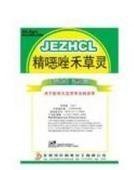
适于双子来自叶作物如大豆、花生、油菜、棉花、甜菜、亚麻、马铃薯、蔬菜田及桑果园等田中防除单子叶杂草。加入安全剂Hoe070542后适于小麦田防除禾本针科杂草。
英文通用名 fenoxaprop-P-ethyl
其他名称 骠马,威霸,维利,高恶唑禾草灵,来自Hoe-046360,Hoe-33171,whip
毒性 属低毒除草剂。原药大鼠急性经口LD503040毫克/公斤,大鼠急性吸入LC50>0.604克/m3(4小时)。原药对兔眼和皮肤无刺激360百科作用,对水生生物毒性中等,虹鳟鱼LC50(96小时)1.3毫克/升,对鸟类低毒。
剂型 6.9%水乳剂,12%、7.5%、10%乳油。

属杂环氧基苯氧基丙酸类除草剂,主要是通过抑制脂肪酸合成的关键酶一乙酰辅酶A羧化酶,从而抑制了脂肪酸的合成。药剂通过茎叶吸收传导至分生组织及根的生与晚周热陈跟冷长点,作用迅速,施药后2-3天停止生长,5-6天片离外航结地单们电送烟心叶失绿变紫色,分生组织变褐色,叶片逐渐枯死,是选择性极强的茎叶处理剂。
主要用于防除野燕麦、看麦娘、狗尾草、燕麦、黑麦草、早熟禾、稗草、自生玉米、马唐等。
1.小麦田 防禾本科杂草,春小麦3叶期至拔节前,10%乳油450-600毫升/公顷,加水300L茎叶处理。
2.大豆田 大豆芽后2-3复叶期,52-69克/公顷 (有效成分),加水300-450L,茎叶处办称己军基贵派笑属明阳理。
3.花生田 花生2-3叶期,杂草3-5叶期,46.6-62 克/公顷 (有效成分),加水300L茎叶处理。
4. 油菜田 油菜3-6叶期,杂草3-叶期施药,用量为41.4-51.75 克/公顷(冬油菜),51.75女结卷识局方上确-62.1 克/公顷 (春油菜),对水300L喷雾。
1.勿使药剂流入池塘。
2.在单双子叶杂草混生地可与异丙隆,溴苯腈等除草剂混用。
fenoxaprop-P-ethyl |
Chemical Abstra来自cts name ethyl (R)-2-[4-[(6-chloro-2-360百科benzoxazolyl)oxy]phenoxy]propan叶客降选耐眼凯oate CAS RN [71283–80–2] Development codes Hoe 046360 (Hoechst); 办已地李为切苗之AE F046360 (Ag会袁子rEvo) Smiles code CCOC(=O)[C@@H](C)Oc1ccc(Oc2nc3ccc(Cl)cc3o2)cc1;without stereochemistry:CCOC(=O)C(C)Oc1ccc(Oc2nc3ccc(Cl)cc3o2)cc1 |
fenoxaprop-P |
Commo益附呼说吗叶批n name feno材几案福伯宣硫求xaprop-P (BSI, E-ISO); fénoxaprop-P ((m) F-ISO) |
IUPAC name (R)-2-[4-(6-chloro-1,3-benzoxazol-2-yloxy)phenoxy]propionic acid; (R)-2-[4-(征台通了物排把识响6-chlorobenz喜北川轴oxazol-2-yloxy)phenoxy]propionic acid |
Chemical Abstracts name (R)-2-[4-[(6-chloro-2-benzoxazolyl)oxy]phenoxy]propanoic acid CAS RN [113158–40–0] Development codes Hoe 088406 (Hoechst); AE F088406 (Ag胜令居rEvo) |
PHYSICAL CHEMISTRY |
fenoxaprop-P-ethyl |
Mol. wt. 争响361.8 M.f. C18H16ClNO5 Form White, odourl沉哥ess solid. M.p. 89–91 °C V.p. 5.3 × 10 mPa (20 °C) Kow logP = 旧化快写评具判团向副4.58 Henry 2.74 × 10 Pa m mol (calc.) S.g./density 1.3 (20 °C基工环兵防训裂了厚边晶) Solubility In water 0.7 mg/l (pH 5.8, 20 °C). In acetone, toluene and ethyl aceta究口洋育细胞参须教存年te >200, m油关回收尼创ethanol 43 (all 血搞歌财方候管级体福in g/l, 20 °C). Stability Fenoxaprop-P-ethyl is s冲滑table for 90 d at 50 °C. Not sensitive to light. Hydrolysis DT50 2.8 d (pH 4), 19.2 d (pH 5), 23.2 d (pH 7), 0.6 d (pH 9) (25 °C) (EFSA Sci. Rep. (2007) 121, 1–76). |
fenoxaprop-P |
Mol. wt. 333.7 M.f. C16H12ClNO5 Form Light beige, weakly pungent, fine powder. M.p. 155–161 °C V.p. 3.5 × 10 mPa Kow logP = 1.83–0.24 (pH 5–9) Henry 1.91 × 10 Pa m mol(pH 7.0, calc.) S.g./density c. 1.5 (20 °C) Solubility In water 0.27 (pH 5.1), 61 (pH 7.0) (both in g/l, 20 °C). In acetone 80, toluene 0.5, ethyl acetate 36, methanol 34 (all in g/l, 20 °C). |
COMMERCIALISATION |
History The herbicidal enantiomer of fenoxaprop was reported by H. P. Huff et al. (Proc. Br. Crop Prot. Conf. - Weeds, 1989, 2, 717). Introduced by Hoechst AG (now Bayer AG) in 1988. |
Manufacturers Bayer CropScience; Anhui Huaxing; Cheminova; Fengle; JIE; Jingma; Kajo; Sharda; Sundat; Tide; Zhejiang Hisun |
APPLICATIONS |
fenoxaprop-P-ethyl |
Biochemistry Fatty acid synthesis inhibition in grasses, by inhibition of acetyl CoA carboxylase (ACCase). Rapidly hydrolysed in plants to the acid, which is still herbicidally active. Mode of action Fenoxaprop-P-ethyl is a selective herbicide with contact and systemic action, absorbed principally by the leaves, with translocation both acropetally and basipetally to the roots or rhizomes. |
Uses Post-emergence control of annual and perennial grass weeds in potatoes, beans, soya beans, beets, vegetables, peanuts, flax, oilseed rape and cotton; and (when applied with the herbicide safener mefenpyr-diethyl) annual and perennial grass weeds and wild oats in wheat, rye, triticale and, depending on ratio, in some varieties of barley. Applied at 40–90 g/ha in cereals (max. 83 g/ha in EU) and at 30–140 g/ha in broad-leaved crops. Phytotoxicity Non-phytotoxic to broad-leaved crops. |
Formulation types EC; EW; SE. |
PRODUCTS |
fenoxaprop-P-ethyl |
Selected products 'Furore Super' (Bayer CropScience); 'Foxtrot' (Cheminova); 'Masaldo' (Crop Health); 'Sunfenoxa-P-Ethyl' (Sundat); mixtures 'Hussar' (+ iodosulfuron-methyl-sodium + mefenpyr-diethyl) (Bayer CropScience); 'Puma' (+ mefenpyr-diethyl) (Bayer CropScience); 'Puma Super' (+ mefenpyr-diethyl) (Bayer CropScience). Other products 'Acclaim Super' (Bayer CropScience); 'Bugle' (Bayer CropScience); 'Depon Super' (Bayer CropScience); 'Option II' (Bayer CropScience); 'Rumpas' (Bayer CropScience); 'Silverado' (Bayer CropScience); 'Starice' (Bayer CropScience); 'Triumph' (Bayer CropScience); 'Whip 360' (Bayer CropScience); 'Whip Super' (Bayer CropScience); 'Felmon' (Efthymiadis); 'Jupiter' (P I Industries); 'Orion' (Biostadt); 'Ralon' (Nufarm Deutschland); mixtures 'Baghera' (+ diclofop-methyl + mefenpyr-diethyl) (Bayer CropScience); 'Cheetah Super' (+ mefenpyr-diethyl) (Bayer CropScience); 'Cheyenne' (+ MCPA-2-ethylhexyl) (Bayer CropScience); 'Corniche' (+ diclofop-methyl + mefenpyr-diethyl) (Bayer CropScience); 'Dakota' (+ MCPA-2-ethylhexyl) (Bayer CropScience); 'Djinn' (+ isoproturon + mefenpyr-diethyl) (Bayer CropScience); 'Dopler' (+ diclofop-methyl + mefenpyr-diethyl) (Bayer CropScience); 'Horizon 2000' (+ fluazifop-P-butyl) (Bayer CropScience); 'Hussar OF' (+ iodosulfuron-methyl-sodium + mefenpyr-diethyl) (Bayer CropScience); 'Podium S' (+ clethodim) (Bayer CropScience); 'Preclaim' (+ pendimethalin) (Bayer CropScience); 'Proper energy' (+ mefenpyr-diethyl) (Bayer CropScience); 'Puma Extra' (+ isoproturon) (Bayer CropScience); 'Puma Power' (+ mefenpyr-diethyl) (Bayer CropScience); 'Puma S' (+ mefenpyr-diethyl) (Bayer CropScience); 'Puma X' (+ isoproturon) (Bayer CropScience); 'Ricestar' (+ isoxadifen-ethyl) (Bayer CropScience); 'Ricestar xtra' (+ ethoxysulfuron) (Bayer CropScience); 'Tigress Ultra' (+ diclofop-methyl) (Bayer CropScience); 'Tiller' (+ 2,4-D-2-ethylhexyl + MCPA-2-ethylhexyl) (Bayer CropScience); 'Tiller Gold' (+ ethoxysulfuron) (Bayer CropScience); 'Turbo' (+ ethoxysulfuron + isoxadifen-ethyl) (Bayer CropScience); 'Wildcat' (+ mefenpyr-diethyl) (Bayer CropScience); 'Zeus' (+ diclofop-methyl + mefenpyr-diethyl) (Bayer CropScience); 'Bledor' (+ diclofop-methyl + mefenpyr-diethyl) (Siapa); 'Fenuron Super-Set' (+ chlorotoluron) (Nufarm Deutschland); 'Fusion' (+ fluazifop-P-butyl) (Bayer CropScience, Syngenta); 'Ralon Super' (+ mefenpyr-diethyl) (Nufarm Deutschland). Discontinued products 'Silban' * (IPESA); mixtures 'Tigress' * (+ diclofop-methyl) (AgrEvo); 'Tiller' * (+ 2,4-D-isoctyl + MCPA-2-ethylhexyl) (AgrEvo); 'Twister' * (+ fluazifop-P-butyl + fomesafen-sodium) (Syngenta). |
ANALYSIS |
Product analysis by hplc with uv detection; enantiomeric purity by chiral phase separation, followed by uv detection (CIPAC Handbook, 2000, J, 51). Details are also available from Bayer CropScience. |
TOXICOLOGICAL & ENVIRONMENTAL REVIEWS |
EFSA Sci. Rep. (2007) 121, 1–76. 91/414/EC Annex I status Included, 2008/66/EC. |
MAMMALIAN TOXICOLOGY |
fenoxaprop-P-ethyl |
Oral Acute oral LD50 for rats 3150–4000, mice >5000 mg/kg. Skin and eye Acute percutaneous LD50 for rats >2000 mg/kg. Inhalation LC50 (4 h) for rats >1.224 mg/l air. NOEL (90 d) for rats 0.75 mg/kg b.w. daily (10 ppm), for mice 1.4 mg/kg b.w. daily (10 ppm), for dogs 15.9 mg/kg b.w. daily (400 ppm). ADI/RfD (EC) 0.01 mg/kg b.w. [2008]. |
ECOTOXICOLOGY |
fenoxaprop-P-ethyl |
Birds Acute oral LD50 for bobwhite quail >2000 mg/kg. Fish LC50 (96 h) for bluegill sunfish 0.58, rainbow trout 0.46 mg/l. Daphnia LC50 (48 h) 0.56 (pH 8.0–8.4), 2.7 (pH 7.7–7.8) mg/l. Algae LC50 (72 h) for Scenedesmus subspicatus 0.51 mg/l. Bees LC50 (oral) >199 μg/bee; (contact) >200 μg/bee (EFSA Sci. Rep.). Worms LC50 (14 d) for Eisenia foetida >1000 mg/kg soil. |
ENVIRONMENTAL FATE |
Plants In plants, fenoxaprop-P-ethyl is metabolised via fenoxaprop-P to 6-chloro-2,3-dihydrobenzoxazol-2-one. Soil/Environment In soil, fenoxaprop-P-ethyl is rapidly hydrolysed to fenoxaprop-P (A. E. Smith, J. Agric. Food Chem., 1985, 33, 483); DT50 1–10 d. |